|
II
Impact of a Falling Birth Rate and Aging Population on Society
Naohiro Ogawa
Deputy Director of Nihon University Population Research institute
Good afternoon. My name is Naohiro Ogawa. Today I will be mainly talking about Japan.
When we think about the meaning of an "aging population", there is in fact no clear definition. There is no official definition of a certain percentage of elderly people in the population that would constitute an aging society. In a 1957 U.N. report, "aging society" is defined as "relative increase in elderly persons and relative decrease in youth". In short, we can say that aging society is brought about by two factors: "people not being born" and "people not dying".
To look at the first factor of people not being born, this graph representing the probability of birth and marriage from 1951 to 2000 shows a sudden and clear change around the time of the oil shock in 1975. (Fig(1))
| (拡大画面:42KB) |
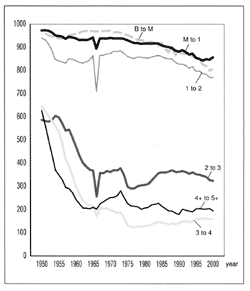 |
Fig(1)
By analogy, we can compare this to hurdles in track and field. Using this approach, we can consider marriage and having children as a series of hurdles over the period from 1951 to the oil shock in 1973. Everyone was able to clear the first hurdle of marriage without any problem. You can see that it was not so difficult to have the first child, and that having the second child was not much of a problem either. Having the third child and fourth child was difficult, and that put the brake on fertility. Rapid decline in births of a third child and fourth child owing to hardships of life and other reasons lowered Japan's fertility rate and gave rise to the norm of having two children in the family. (Fig(2)) (Fig(3))
| (拡大画面:28KB) |
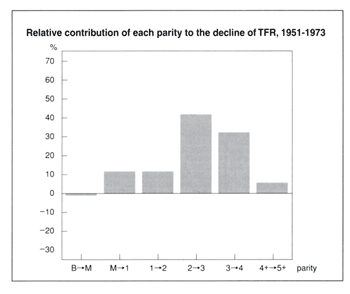 |
Fig(2)
| (拡大画面:35KB) |
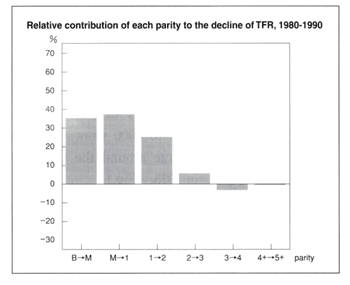 |
Fig(3)
A completely different picture emerged after entering the '80s. The first hurdle, marriage, became very difficult to clear and not everyone could get over. This relates to the phenomenon known as "late marriage". The first child also became a high hurdle. However, the third and fourth child became less of a hurdle, which means that couples often gave birth to a third and fourth child once they had one child. It was in the '80s that couples were polarised to those with no children and those with three or four children.
The situation changed considerably again in the '90s. Marriage was still a major hurdle and the probability of having the first child after marriage increased even higher. The definition of DINKS (double income couples with no kids) may vary but their situation is changing dramatically. (Fig(4))
| (拡大画面:40KB) |
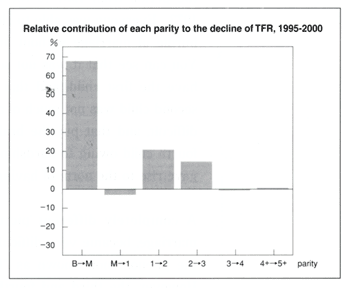 |
Fig(4)
This is the graph for the year 2000. Marriage represents a very high hurdle again in recent years and has reached an unprecedented high level. A point that is surprisingly overlooked is that late marriage is becoming the largest cause of the falling birth rate. We therefore need to give this phenomenon more consideration.
Another significant characteristic is the fact that giving birth to a second child has become quite a large obstacle. Having the first child was difficult in the first half of the '90s and having the second child was difficult in the second half of the '90s.
Incidentally, if the current situation, shown in the previous graph, continues, 20 percent of Japanese women will remain single throughout their lives. The percentage will be nearly 30 percent for men. You may think these estimated values are surprising, but are there male persons living in Tokyo in the audience? If you are almost 40 and single, the statistical chance of you getting married is almost zero. About 35 percent of men in Tokyo are currently unmarried and the percentage of unmarried persons is predicted to go up considerably in the future.
The situation is so pressing that it requires fundamental reconsideration for planning and development in the Tokyo metropolitan area. The topic also came up at the National Land Development
Council when it discussed development in Tokyo. For example, it may perhaps be better to develop communities with many convenience stores to meet the needs of single men than pursuing policies for families such as building parks. The magnitude of change is large enough to force such a fundamental shift in our outlook and lifestyles.
The wage function has been estimated from micro-data gathered in a public-opinion survey conducted by the Mainichi Newspapers. The result (relevant table omitted*) shows the wages for men and the rate of returns for junior high school, high school, junior college and college graduates based on their annual income. For instance, if you compare the difference in income between junior high graduates and college graduates in 1990 and 2000, the income has slightly improved for college graduates in 2000.
The scenario is totally different for women, with college graduates demonstrating a very favourable return. The percentage of women proceeding to junior college and college has increased rapidly in Japan, and, as you may know well, exceeded that of men in 1989. There were more women in school than men at junior colleges and colleges combined. I often tell my male students that they do not need to go to college because it's not efficient. It may be better to have more women enroll in college because they statistically yield better return on their investment towards education.
This may also serve to increasingly change their ideas about marriage. Since education is the greatest reason from the statistical viewpoint for delaying marriage, the age of marriage may be delayed all the more.
Another major factor that determines aging in addition to marriage is the delay in birth of a second child that I mentioned earlier. Also using a survey conducted by the Mainichi Newspapers to analyse this, we can see that 30 percent of the respondents throughout Japan responded "Yes" to the question "Did the collapse of the bubble economy influence your decision about when or whether or not to have a child?" There was a significant difference in the socio-economic status of those affected and those who were not. When classified by age, academic background, job type, wife's income, husband's income and urban or rural residence, roughly 72 percent of the respondents of lower economic status said they were affected while only 2.9 percent of these of higher economic status said they were not. (Fig(5))
| (拡大画面:80KB) |
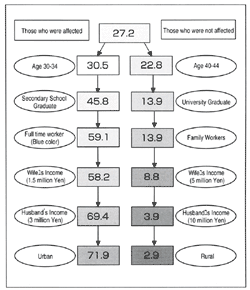 |
Fig(5)
However, with a third of the overall population being affected by the collapse of the bubble economy the seriousness of the situation is revealed. Furthermore, the group of people affected by the collapse of bubble economy represented every segment of Japanese society. In short, not being able to expect long-term income stability had become a factor contributing to fertility decline.
The bubble economy started collapsing around 1991, and inappropriate measures taken by the Japanese government gave rise to serious problems as well. As you may well know, measures taken against the collapse of bubble economy were delayed because it was initially seen as a part of the economic cycle. In 1996, Japan demonstrated a growth rate of 3.4 percent, which was the highest growth rate among the developed countries. Looking back, it was a temporary recovery made possible by the permeation of government investments and loans offered after the Great Hanshin Earthquake. The economy fizzled out again after these measures lost their effect, and appropriate measures were not taken by the Hashimoto Administration. The delay in taking subsequent measures by the Obuchi Administration made the situation worse.
It took Japan 20 years after the reform carried out by the Thatcher Administration of the United Kingdom to realise the need to carry out structural reform due to globalization. Surprisingly, the impact of globalization has been working as a very important mechanism behind the present decline of fertility in Japan. This implies that the speed of recovery of the Japanese economy would have a big impact on the country's fertility. A report from the Council on Fiscal and Economic Policy announced January 19 of this year presented a scenario of the Japanese economy recovering to stable economic growth by 2004. There is no telling whether or not this would be realized as it relies on the extent of meeting all the preconditions attached to it − i.e. raising the consumption tax by 1 percent and cutting public spending such as government investments and loans by 3 percent every year from the level of the previous year.
Therefore, proper macro-economic management is an important key to recovering Japan's fertility. If macro-economic management is performed properly, there is at least a possibility of solving considerably the problem of delays in terms of timing of births. In short, I think government management that would enable the people to have a positive outlook for a stable economy is very important.
You will see things differently if you look at the issue from a micro-level. Interesting results are obtained when you analyse the results of the Mainichi survey on a personal level.
To begin with, those showing the highest concern about the falling birth rate and aging population are mostly men. The concerns are over the future of their pensions and the vitality of Japanese society. However, these same men are neglecting or have neglected a role they could play to contribute to improved fertility. The Mainichi survey results show that whether or not a woman wants to marry at an early age depends on the amount of cooperation her father offered to the family around the time when she graduated from elementary school. In other words, the extent to which men participated in the household has become the greatest determining factor in whether a daughter would want to marry at an early age or not. In sum, fertility will not recover without implementing reform on the micro-level. It is therefore similar to environmental problems in that we have to "think globally, act locally". We have to start working on the family level. Going home and helping with household duties may be the quickest route to recovering fertility in Japan, although it would take 15 years to do so.
Let us also take a look at the peak of fertility. There is hardly any time for taking measures against fertility decline and the problem is imminent. This is because the number of women of child-bearing age will increase for the next 3 to 4 years but will decrease rapidly thereafter. This is probably the last time we will have so many women of child-bearing age. It means that the second baby boomers are reaching their child-bearing age. There won't be another chance for taking fertility measures after this. The number of births will take a sharp decline after this. Policies will have to be implemented within the next 3 to 4 years to be effective.
Previously, I said that aging of population is the result of people not dying and not being born. This is what you'll find from an analysis of the mortality rate and fertility rate. Initially, babies not being born was the dominant factor behind rapid advancement of aging. The situation will change drastically from here on as the mortality rate starts to have a larger impact than the fertility rate. Everyone in the media is now using the phrase "falling birth rate and aging population", but there is a big pitfall to this. If you analyse the present situation, the falling birth rate is becoming less of a problem than before. Longevity is starting to have greater impact on population aging and is becoming a factor that cannot be ignored. Aging of population is ultimately determined by what happens to the limit of human longevity. I don't think any of you here today would want to die soon, but we drift into a dilemma of population aging advancing the longer we all wish to live.
To analyse longevity, we calculated at the Population Research Institute the average age of 50 of the oldest people that died every year. The calculation has been completed for the years 1950 through 2000. The average age was increasing slowly from 1950 to 1975. However, the highest age of death started increasing notably from 1975 onward. The average age of 50 of the highest ages of death for women is currently 108 years. The average age of the oldest 50 persons has been increasing at an incredible rate every year. A couple of days ago, a Japanese man became the world's oldest living male at age 112. Our institute is currently studying super-centenarians − people aged 110 years and above. Since the number of these people is becoming too large to ignore, we are planning to conduct a joint project with France and Sweden. In view of these matters, there is scope for further extension of longevity.
|